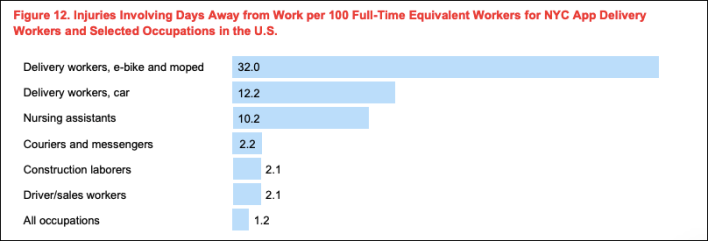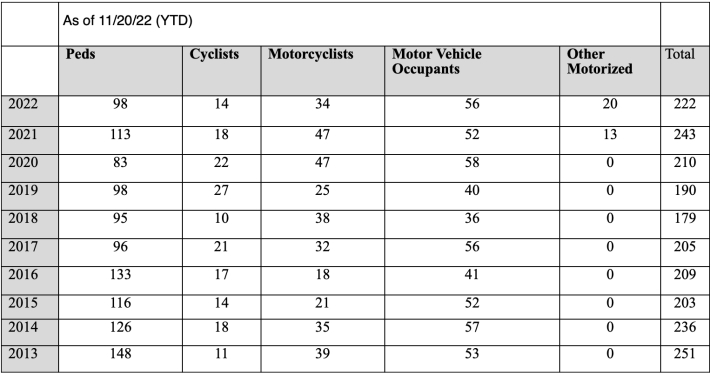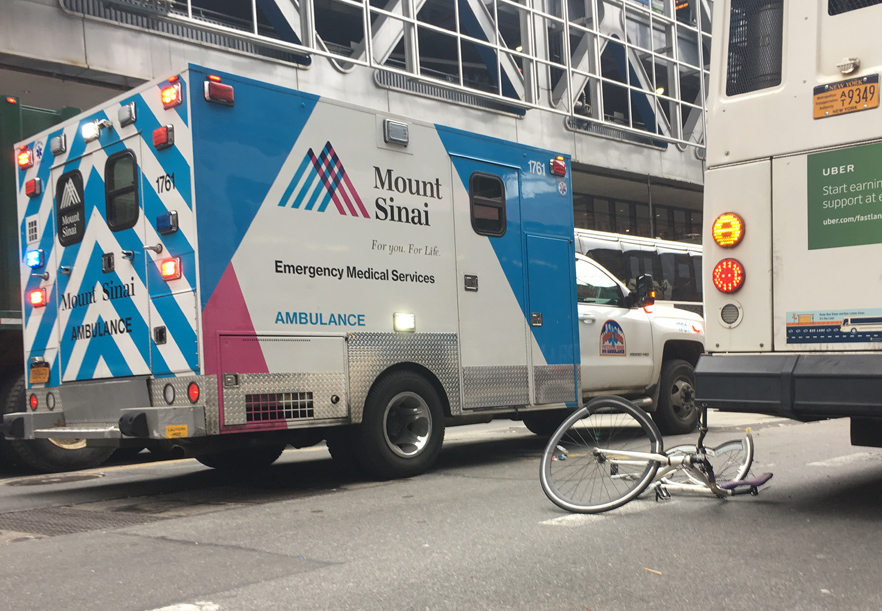More money, more problems?
Buried in a new city report calling for a significant pay raise for the city’s nearly 65,000 delivery workers is a small, but potentially significant, prediction: the number of deliveries made per hour will increase from 1.6 to 2.5 per worker, unleashing more two wheeled deliveristas crisscrossing the city’s deadly streets at all hours of the day and night.
A liveable minimum wage is just the first step in ensuring delivery workers’ safety and livelihoods, advocates say — the next is building out the infrastructure necessary to meet the demands of the industry’s growth. As part of the proposed pay increase to $23.82 per hour in the next three years, the Department of Consumer and Worker Protection projects that the number of deliveries will jump 35 percent by 2025 — making it even more imperative that the city simultaneously build out more protective infrastructure.
And especially where the majority of those deliveries are concentrated, like in wealthier sections of Brooklyn and Queens and in Manhattan below 110th Street — the same neighborhoods where residents have sought to ban delivery cyclists from bike lanes and bathrooms.
“We need to keep adding bike lanes and I think that’s the first step,” said Hildalyn Colón Hernández, director of Policy and Strategic Partnerships of Los Deliveristas/Workers Justice Project.

On Monday, members of Los Deliveristas/Workers Justice Project demanded that the city add $5 to the $23.82 per hour minimum pay proposal, citing costly upkeep and expenses as part of the dangerous working conditions they experience as they keep New Yorkers fed through rain, sleet, and snow — most often on electric bicycles that can cost more than $1,000 a piece for just the battery alone.
But a much-needed wage hike can’t be done in silo without addressing the lack of protected bike lanes across the five boroughs, leaving delivery workers — the majority of who are low-income men of color — vulnerable to traffic violence and other crimes.
“Deliveristas’ working conditions became more precarious during the pandemic and continues today. Deliveristas suffer from workplace violence daily. Many of them confront unsafe streets and are victims of violent assaults, even at gunpoint, in an attempt to steal their e-bikes or mopeds, which are the primary tools of their work,” Los Deliveristas Unidos/Workers Justice said in a statement. “Many are victims of fatalities, disabled, injured, or made unwell as they fulfill orders for the apps under unrealistic and dangerous expectations to arrive at the assigned location under any condition: rain, shine, extreme weather, like snowstorms, freezing rain, and even hurricanes.”
We appreciate the city’s effort to release a proposed min pay, but it’s NOT enough. We do one of the most dangerous jobs, enduring the hardest working conditions while delivering NYers food during snowstorms & hurricanes.
We need $5 more to get by as essential workers. ?#LDU pic.twitter.com/dyRAzpr1p2
— gustavo ajche (@AjcheGustavo) November 21, 2022
Working cyclists, and specifically app-based delivery workers, have one of the most dangerous jobs in the city, now ranking higher than some of the most historically deadly jobs, including construction workers and nursing assistants, according to a study released last week by the Department of Consumer and Worker Protection. And they’re dying at rapid rates. Since 2020, 33 delivery workers have been killed on the job — 26 of which were the result of traffic violence. Five were killed in robberies and two of their deaths are unknown, according to the report.

And the proposed minimum hourly pay is meant to address those dangers — albeit not enough, workers say.
After a two-year phase-in, according to the Department of Consumer and Worker Protection, the app-based delivery companies like Uber Eats, DoorDash, GrubHub, and Relay, which are opposed to the proposal, would have to pay delivery workers a minimum of $23.82 per hour, excluding tips. Now, on average, they bring home just $7.09 per hour, excluding tips.
It’s unclear exactly how the projected increase in deliveries will impact the job, and whether it’ll mean more or less mileage for workers, or faster or slower speeds. Workers can already set their own limits on how far they travel, thanks to new legislation passed last year, as part of the holistic reforms to the industry.
But according to the report, the increase in deliveries per hour will be the result of more efficiency in the app itself, including changes like a reduction in what’s called on-call time — the waiting period between deliveries while still on the app — and better matching supply to demand, like having a worker pick up two orders from the same restaurant and delivering them one after the other. Two deliveries are made but the travel time and distance may be shortened, according to the report.
What is clear, though, is that the demand is growing and the city must meet it, not only with adequate pay but with safer streets.
“Delivery workers, like all New Yorkers, deserve a living wage, and the City of New York needs to follow through. Workers have the right to a safe workplace: for our city’s delivery workers, this means a network of safe, protected bike lanes that help prevent crashes. Delivery workers face a higher rate of days missed from work because of injuries and often lack health insurance to cover related costs — safer streets is a matter of economic justice,” said Elizabeth Adams, Senior Director of Advocacy and Organizing at Transportation Alternatives.
A spokesperson for DOT said the Department of Consumer and Worker Protection’s report highlights the importance of live-saving infrastructure, including on critical corridors like Schermerhorn Street in Brooklyn and Northern Boulevard in Queens.
“This report underscores the importance of DOT’s life-saving work to deliver safe cycling infrastructure and the intersectional benefits of these projects. Data shows bike lanes improve safety for all road users, including often overlooked communities, such as older New Yorkers and delivery cyclists,” said Vin Barone.
And it’s not just a need for more protected bike lanes, but also charging stations that allow delivery workers to safely power up their e-bike’s lithium-ion batteries — a recent flashpoint as the number of deadly fires stemming from faulty batteries has skyrocketed. Last month, after backlash, the city backed down from a contentious policy proposal that sought to bar e-bikes anywhere on New York City Housing Authority property.
“I support the 65,000 Deliveristas who deliver food to New Yorkers in all kinds of weather, at all hours, and in difficult road conditions,” said Manhattan Council Member Gale Brewer, who introduced legislation banning the sale and assembly of second-use lithium ion batteries. “As an elected official who is advocating for safer batteries for e-bikes, I know that the new, safe batteries cost more; I support increasing the expense rate in the rule by $5 to address these work tools.”
But being able to afford a proper battery is only as good as one’s ability to charge it, said Colón Hernández. Last month, Sen. Chuck Schumer, the city, and Los Deliveristas Unidos, announced a new initiative to create new charging stations for delivery workers out of retrofitted newsstands – but it so far includes only one in lower Manhattan.
“Another thing that needs to happen on the transportation side is we need to address the issue of charging, we need to provide the infrastructure,” she said.
And lastly, the city needs to educate not only workers who use mopeds, but also members of the NYPD and FDNY, for whom the many different variations of two-wheeled devices has been a point of confusion.
“We need to address the need for clear guidelines, it’s an issue for many workers who actually register mopeds, said Colón Hernández.
New York City roadways remain exceptionally dangerous, according to DOT stats:

Comments on the proposed new wages can be submitted ahead of the public hearing on Dec. 16. Comments can be sent to rulecomments@dcwp.nyc.gov or mailed to DCWP, 42 Broadway; New York, New York 10004






